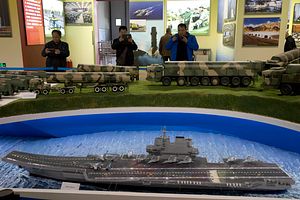In recent months, a number of new developments and interesting pictures and rumors have emerged in relation to the Chinese Navy’s (PLAN’s) aircraft carrier projects. Pictures tracking CV-16 Liaoning over the past year as well as carrier 002 at Dalian shipyard demonstrate both vessels have reached various milestones in recent months. Pictures of carrier 003 being built at Jiangnan shipyard similarly give new insights into its potential final size.
This piece will review these recent developments in context of what has been previously rumored for the PLAN carrier program. Projections of future carrier development and procurement trajectories will also be considered, including the topic of carrier airwings.
Which carrier is which?
It is first necessary to understand which name refers to which carrier. In the past, a number of English language publications have used the names “001A” to refer to the ski jump carrier built in Dalian, and “002” to refer to the catapult equipped carrier currently being built in Jiangnan. Indeed, these names have continued to be used, even among some Chinese state affiliated media.
“001A” and “002” were in use for a number of years prior to 2018 in the Chinese defense watching community as well; however in 2018 this designation system was turned on its head when a photograph of a China Shipbuilding Industry Corporation meeting revealed the designation of “002 aircraft carrier.”

The original photo of the CSIC meeting; note the words “002 aircraft carrier” (Source: China Shipbuilding Industry Corporation)
The official Dalian shipyard website accompanying the original photo described the need to continue with “stable testing work” and “production trials” – therefore the only possible way to reconcile this information is for 002 to refer to the ski jump carrier built at Dalian, which at that time was the only aircraft carrier that was undergoing sea trials. Further suggesting that the above photo had likely revealed “too much,” the Dalian shipyard website detailing the story later doctored the original image of the meeting, changing the words “002 aircraft carrier,” to “important project/unit” instead.

The doctored photo, where “002 aircraft carrier” has been replaced with the words “important project,” in what is clearly a different font to the other words on the display plaque (Source:China Shipbuilding Industry Corporation)
Based on the above episode, the previous designation system had become obsolete in Chinese military watching circles, and the current series of designations are used instead:
- CV-16 Liaoning (sometimes referred as carrier 001): As China’s first aircraft carrier in service, this vessel was once commonly known as the Varyag. No change in name or designation.
- Carrier 002 (formerly known as “001A,” and is also sometimes referred to as CV-17, and may be named Shandong once commissioned): This ski jump carrier is derived from the CV-16 design, and is China’s first domestically built carrier which was launched from Dalian shipyard in 2017 and has been undergoing sea trials since mid 2018.
- Carrier 003 (formerly known as “002,” and is also sometimes referred to as CV-18): Currently under construction at Jiangnan shipyard in Shanghai, this will be China’s second domestically built carrier and China’s first aircraft carrier equipped with catapults.
- Carrier 00X or 004 (formerly known as “003”): This designation has been used to refer both to China’s first eventual nuclear powered aircraft carrier, or a second conventional carrier equipped with catapults.
A range of recent and current news articles, commentaries, and analyses continue to use the older and obsolete “001A/002” naming system, however in the Chinese PLA watching community those designations are not considered up to date or valid.
Carrier 003
For many years now, the ship now known as 003 was rumored as a conventionally powered, catapult equipped aircraft carrier. The full displacement of 003 had been given across a range anywhere between 75,000 tons to 85,000 tons. It has been accepted for a few years now that 003 will very likely use electromagnetic catapults to launch aircraft, forgoing steam catapults. However, it is not yet known what type of conventional propulsion arrangement the vessel will use to facilitate the electric power for its electromagnetic catapults, though some form of steam propulsion has been described in the past.
003 is currently being constructed at Jiangnan shipyard in Shanghai. The first pictures of 003’s modules made their way onto the internet in June 2018. Since then, more pictures have emerged showing additional modules emerging and undergoing assembly. Of note, a satellite photo contracted by the Center for Strategic and International Studies (CSIS) provided a useful estimate for the beam of one of the hull modules, giving it at ~41 meters, consistent with what would be expected for a carrier of this size, however it was incorrectly named “002” using the older obsolete designation.
The construction of 003 had been rumored to be somewhat unique, whereby the ship’s modules would first be assembled at a staging area into “super blocks” of very large and complete hull sections. Those “super blocks” would then be transported by water to a drydock elsewhere in the shipyard for final assembly of the super blocks and assembly of additional flight deck sponsons and topside modules such as the island. Finally, the ship would be launched from drydock for fitting out.
As of mid 2019, none of the “super blocks” have yet to be transported to a drydock as they are still in assembly. The first “super blocks” may be transported to a drydock in late 2019 or by mid 2020 at the latest. After drydock assembly is complete, 003 is likely to be launched overall in 2021. Assuming it takes two years of fitting out and sea trials, the current estimated commissioning the carrier 003 is the year 2023.
Carrier 002
Construction of aircraft carrier 002 at Dalian shipyard was first photographically confirmed in early 2015. The ship was launched in April 2017, and began sea trials one year later in April 2018. Recent pictures of 002 from May this year have revealed tire marks on the landing strip, indicating that aviation trials with fixed wing aircraft (J-15s) have begun. Carrier 002 is expected to be commissioned by the end of 2019.
002 is a ski jump-equipped carrier derived from the design of CV-16 Liaoning. The ship enjoys various modifications from Liaoning, such as a significantly redesigned island and overall smaller island footprint, as well as redesigned, larger weapons elevators. Similar to Liaoning, 002 is only capable of accommodating ski jump launched J-15 fighters and helicopters at this time. It is unknown if future catapult compatible fighters will be designed to operate from ski jump carriers like 002 and Liaoning.
Carrier 002 can be thought of as another “bridging carrier” toward the PLAN’s ultimate and preferred carrier configuration of fielding large catapult-equipped vessels instead. However the vessel is still very much designed and equipped as a warship commensurate with its size and role, and will likely supplement CV-16 Liaoning in the role of developing aircraft carrier proficiency as well as doubling wartime aircraft carrier availability if a crisis emerged in the near future requiring the use of CV-16 or 002 in anger.
Liaoning
CV-16 Liaoning, also known as the ex-Varyag, is an aircraft carrier purchased from Ukraine when it was half finished and overhauled and refitted into a combat capable vessel. While it is often described as a “training carrier” in commentaries and media (both English and Chinese), it is clear that the vessel itself is fitted with the requisite sensors, weapons and facilities to be a combat capable warship. However, given the PLAN’s relative inexperience in operating aircraft carriers, CV-16 has served a predominantly training role.
CV-16 returned to Dalian shipyard in mid 2018 for maintenance and refit, where the island structure was altered and presumably additional upgrades were made internally. After its refit, Liaoning participated in the PLAN 70th anniversary naval review. And more recently, Liaoning and an escort force including a 901 comprehensive resupply ship passed through the first island chain into the western Pacific, presumably for a training deployment. It will likely be another few years yet until Liaoning will have to return to a shipyard for a major overhaul.
Beyond 003
Currently there is no confirmation as to what will follow aircraft carrier 003 in the coming years. It is widely accepted that the PLAN will be pursuing a nuclear powered carrier which may emerge by the mid to late 2020s, and is sometimes referred to as “004” or as “00X.” Recent rumors have suggested Dalian shipyard is currently undergoing rework or retooling of some sort to enable construction of the eventual nuclear powered aircraft carrier. Presumably this ship will be both larger and more capable than 003.
However, there currently is a lack of any firm indications for carrier plans between 2019 and the mid to late 2020s. One widely circulated rumor suggests that a second conventional, catapult equipped carrier similar or identical to carrier 003 will be constructed, however it is not yet known which shipyard may build this vessel or when construction could conceivably begin. It is possible that Dalian shipyard could build this second conventional catapult carrier, but it has also been rumored that Jiangnan may build this ship without significant pause immediately after work on the current 003.
It is not known whether a second conventional catapult carrier would be described as a “second 003” or as “004.” Taking all of the above into account however, it seems likely that at least one additional conventionally powered catapult equipped carrier will be constructed before work on the PLAN’s first nuclear powered carrier begins. In the longer term, Chinese carrier production will probably settle on a single class or design in the form of a nuclear powered super carrier. Chinese military and government media have stated the need for six carriers in past years, and it is possible this number could be exceeded by the mid 2030s when Chinese nuclear carrier production may be well in its stride.
Finally, a reference must be made to the state of Chinese carrierborne aircraft. At present, only 24 J-15 airframes have been confirmed to be produced for regular service, with a number of prototypes also confirmed to be in existence, including the J-15D electronic warfare variant, as well as a catapult test bed variant. It is not known if additional in service J-15s have also been produced, and it is not yet known if a catapult compatible J-15 variant will be mass produced to serve aboard carrier 003 when it is projected to enter service around 2023.
As written in the past, the 5th generation Chinese carrierborne fighter will be a highly modified variant of the FC-31 fighter. It is currently expected to make its first flight in late 2019 or in early 2020. The aircraft has dubbed with various names including “J-35” and J-XY,” however the final designation is not known. Additionally, it is not known how long the development cycle for this aircraft may take, though some suggestions have placed an in service date by 2025 at the earliest.
A fixed wing airborne early warning and control aircraft called H-600 or KJ-600 is also in late stages of development and is likely to make its first flight within the next couple of years. This aircraft adopts the proven and mature configuration of the E-2 family.
Summary
As of mid 2019, Chinese carrier development has begun to reach a new stage, whereby work on ski jump carriers like CV-16 and 002 will soon end. Soon, all expectations and focus will be on the catapult carriers like 003 and its successors and their related air wings.
Going forwards, it may be wise to re-evaluate and consolidate the designations used for Chinese carriers, so as to avoid identity confusion.
Rick Joe is a longtime follower of Chinese military developments, with a focus on air and naval platforms. His content and write ups are derived from cross examination of open source rumors and information.

































